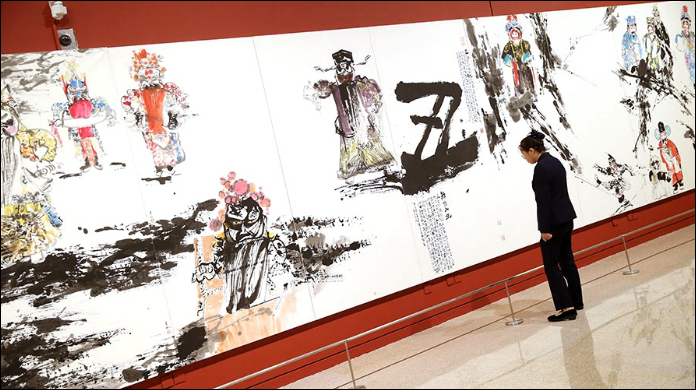
Part of Ma Shulin's over-20-meter collection painting “Life on Stage” on display at his solo exhibition at the National Museum of China in Beijing, China. (Photo :China Daily)
An exhibition currently running at the National Museum of China through Aug 12 provides an overview of the creative career of Ma Shulin, who has been a senior administrator at one of China's top museums for years.
Since the early 1980s, Ma Shulin, the retired deputy director of the National Art Museum of China in Beijing has been exploring ink and color works on the traditional Chinese medium of xuan paper. He has created various award-winning paintings which became the highlight pieces at numerous national exhibitions.
Around 160 of his paintings are on display as a celebration of his achievements in the two main styles of classic Chinese painting: gongbi (meticulous brush strokes) and xieyi (sketching thoughts).
Ma paints a wide range of subjects, from the more traditional flowers, birds, and landscapes, to his better-known portraits of real-life figures and mythical characters.
The exhibits include massive figure paintings shows his experiments in reinterpreting some of the mythical household names in China, such as Guan Yu as an upright, royal general living in the late second century to the early third century, to Sun Wukong, the Monkey King, from Journey to the West.
The iconic characters in traditional Chinese opera classics become vivid in his over-20-meter collection painting “Life on Stage”, which breaks the prototype in Chinese paintings that the opera characters are barely seen in the big-size piece.
Feng Yuan, vice president of China Federation of Literary and Art Circles (CFLAC) spoke highly of Ma’s curatorship and creativity.
Feng noted that “Ma’s Chinese paintings merge the classics in traditional Chinese culture and the features of folk culture,” adding “especially in his figure paintings depicting traditional Chinese opera characters, his unique personal painting style is well presented in a forthright, exaggerated, and explicit way.”


